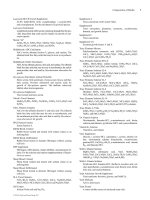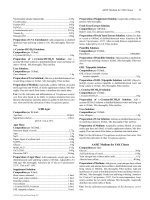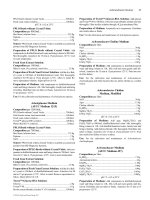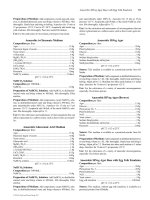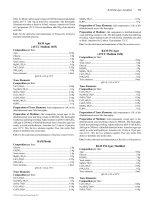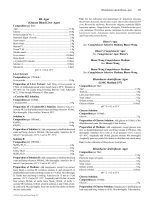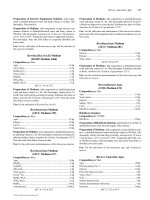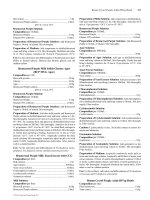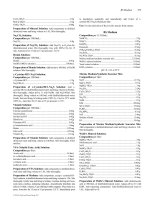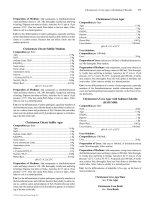Handbook of Microbiological Media, Fourth Edition part 2 pps
Bạn đang xem bản rút gọn của tài liệu. Xem và tải ngay bản đầy đủ của tài liệu tại đây (219.1 KB, 10 trang )
Composition of Media 5
Legionella BCYE Growth Supplement
ACES buffer/KOH, ferric pyrophosphate, L-cysteine-HCl,
and -ketoglutarate. For the enrichment of Legionella species.
Leptospira Enrichment
Lyophilized pooled rabbit serum containing hemoglobin that pro-
vides long-chain fatty acids and B vitamins for growth of Lep-
tospira species.
Metals “44”
ZnSO
4
·7H
2
O, FeSO
4
·7H
2
O, MnSO
4
·7H
2
O, Na
2
B
4
O
7
·10H
2
O,
CuSO
4
·5H
2
O, Co(NO
3
)
2
·6H
2
O, and EDTA.
Middlebrook ADC Enrichment
NaCl, bovine albumin fraction V, glucose, and catalase. The
albumin binds free fatty acids that may be toxic to mycobacte-
ria.
Middlebrook OADC Enrichment
NaCl, bovine albumin, glucose, oleic acid, and catalase. The albumin
binds free fatty acids that may be toxic to mycobacteria; the enrich-
ment provides oleic acid used by Mycobacterium tuberculosis for
growth.
Mycoplasma Enrichment without Penicillin
Horse serum, fresh autolysate of yeast-yeast extract, and thal-
lium acetate. Provides cholesterol and nucleic acids for
growth of Mycoplasma species. The thallium selectively
inhibits other microorganisms.
Mycoplasma Supplement
Yeast extract and horse serum.
Nitsch’s Trace Elements
MnSO
4
, H
3
BO
3
, ZnSO
4
, Na
2
MoO
4
, CuSO
4
, CoCl
2
·6H
2
O, and
H
2
SO
4.
Oleic Albumin Complex
NaCl, bovine albumin fraction V, and oleic acid. The albumin
binds free fatty acids that may be toxic to mycobacteria, and
the enrichment provides oleic acid that is used by Mycobacte-
rium tuberculosis for growth.
PPLO Serum Fraction
Serum fraction A.
Rabbit Blood, Citrated
Rabbit blood washed and treated with sodium citrate as an
anticoagulant.
Rabbit Blood, Defibrinated
Rabbit blood treated to denature fibrinogen without causing
cell lysis.
RPF Supplement
Fibrinogen, rabbit plasma, trypsin inhibitor, and potassium tel-
lurite. For the selection and nutrient supplementation of Staphy-
lococcus aureus.
Sheep Blood, Citrated
Sheep blood washed and treated with sodium citrate as an
anticoagulant.
Sheep Blood, Defibrinated
Sheep blood treated to denature fibrinogen without causing
cell lysis.
SLA Trace Elements
FeCl
2
·4H
2
O, H
3
BO
3
, CoCl
2
·6H
2
O, ZnCl
2
, Na
2
MoO
4
·2H
2
O,
MnCl
2
·4H
2
O, NiCl
2
·6H
2
O, CuCl
2
·2H
2
O, and Na
2
SeO
3
·5H
2
O.
Soil Extract
African Violet soil and Na
2
CO
3
.
Supplement A
Yeast concentrate with Crystal Violet.
Supplement B
Yeast concentrate, glutamine, coenzyme, cocarboxylase,
hematin, and growth factors.
Supplement C
Yeast concentrate.
Supplement VX
Essential growth factors V and X.
Trace Elements Mixture
Ethylenediamine tetraacetic acid (EDTA), ZnSO
4
·7H
2
O,
CaCl
2
, MnCl
2
·4H
2
O, FeSO
4
·7H
2
O, (NH
4
)
6
Mo
7
O
24
·4H
2
O,
CoCl
2
·6H
2
O, and CuSO
4
·5H
2
O.
Trace Elements Solution HO-LE
H
3
BO
3
, MnCl
2
·4H
2
O, sodium tartrate, FeSO
4
·7H
2
O, ZnCl
2,
CoCl
2
·6H
2
O, CuCl
2
·2H
2
O, and Na
2
MoO
4
· 2H
2
O.
Trace Elements Solution SL-6
H
3
BO
3
, CoCl
2
·6H
2
O, ZnSO
4
·7H
2
O, MnCl
2
·4H
2
O, NiCl
2
·6H
2
O,
Na
2
MoO
4
·H
2
O, and CuCl
2
·2H
2
O.
Trace Elements Solution SL-7
FeCl
2
·4H
2
O, CoCl
2
·6H
2
O, MnCl
2
·4H
2
O, ZnCl
2
, H
3
BO
3
,
Na
2
MoO
4
·2H
2
O, NiCl
2
·6H
2
O, CuCl
2
·2H
2
O, and HCl.
Trace Elements Solution SL-8
Disodium EDTA, FeCl
2
·4H
2
O, CoCl
2
·6H
2
O, MnCl
2
·4H
2
O,
NiCl
2
·6H
2
0, ZnCl
2
, H
3
BO
3
, NaMoO
4
·2H
2
O, and CuCl
2
·2H
2
O.
Trace Elements Solution SL-10
FeCl
2
·4H
2
O, CoCl
2
·6H
2
O, MnCl
2
·4H
2
O, NiCl
2
·6H
2
O, H
3
BO
3
,
ZnCl
2
, Na
2
MoO
4
·2H
2
O, CuCl
2
·2H
2
O, and HCl (25% solution).
Trace Metals A-5 Mix
ZnSO
4
·7H
2
O, Co(NO
3
)
2
·6H
2,
O
Na
2
MoO
4
·2H
2
O, CuSO
4
·5H
2
O,
H
3
BO
3
, and MnCl
2
·4H
2
O.
VA Vitamin Solution
Nicotinamide, thiamine·HCl, p-aminobenzoic acid, biotin,
calcium pantothenate, pyridoxine·2HCl, and cyanocobalamin.
Vitamin K
1
Solution
Vitamin K
1
and ethanol.
Vitox Supplement
Glucose,
L-cysteine·HCl, L-glutamine, L-cystine, adenine sul-
fate, nicotinamide adenine dinucleotide, cocarboxylase,
guanine·HCl, Fe(NO
3
)
3
·6H
2
O, p-aminobenzoic acid, vitamin
B
12
, and thiamine·HCl.
Wolfe’s Mineral Solution
MgSO
4
·7H
2
O, nitriloacetic acid, NaCl, MnSO
4
·H
2
O,
FeSO
4
·7H
2
O, CoCl
2
·6H
2
O, CaCl
2
, ZnSO
4
·7H
2
O, CuSO
4
·5H
2
O,
AlK(SO
4
)
2
· 12H
2
O, Na
2
MoO
4
·2H
2
O, and H
3
BO
3
.
Wolfe’s Vitamin Solution
Pyridoxine·HCl, thiamine·HCl, riboflavin, nicotinic acid, cal-
cium pantothenate, p-aminobenzoic acid, thioctic acid, biotin,
folic acid, and cyanocobalamin.
Yeast Autolysate Growth Supplement
Yeast autolysate fractions, glucose, and NaHCO
3
.
Yeast Dialysate
Active, dried yeast.
Yeast Extract
A water-soluble extract of autolyzed yeast cells.
© 2010 by Taylor and Francis Group, LLC
6 Composition of Media
Yeast Extract Powder
A dried extract obtained from yeast cells (Saccharomyces)
prepared under controlled conditions that retains its vitamin
content and other nutritive values such as free amino acids.
Yeastolate
A water-soluble fraction of autolyzed yeast cells rich in vita-
min B complex.
Selective Components
Many media contain selective components that inhibit the growth of
nontarget microorganisms. Selective media are especially useful in the
isolation of specific microorganisms from mixed populations. In many
media for the study of microorganisms in nature, compounds are
included in the media as sole sources of carbon or nitrogen so that
only a few types of microorganisms can grow. Selective toxic com-
pounds are also frequently used to select for the cultivation of particu-
lar microbial species. The isolation of a pathogen from a stool speci-
men, for example, where there is a high abundance of nonpathogenic
normal microbiota, requires selective media. Often, antimicrobics or
other selectively toxic compounds are incorporated into media to sup-
press the growth of the background microbiota while permitting the
cultivation of the target organism of interest. Bile salts, selenite, tetra-
thionate, tellurite, azide, phenylethanol, sodium lauryl sulfate, high
sodium chloride concentrations, and various dyes—such as eosin,
Crystal Violet, and Methylene Blue—are used as selective toxic
chemicals. Antimicrobial agents used to suppress specific types of
microorganisms include ampicillin, chloramphenicol, colistin, cyclo-
heximide, gentamicin, kanamycin, nalidixic acid, sulfadiazine, and
vancomycin. Various combinations of antimicrobics are effective in
suppressing classes of microorganisms, such as enteric bacteria.
Below are some of the selective agents, principally antimicrobic mix-
tures used for the selective isolation of pathogens.
Ampicillin Selective Supplement
Ampicillin. Used in media for the selection of Aeromonas
hydrophila.
Anaerobe Selective Supplement GN
Hemin, menadione, sodium succinate, nalidixic acid, and
vancomycin. For the selection of Gram-negative anaerobes.
Anaerobe Selective Supplement NS
Hemin, menadione, sodium pyruvate, and nalidixic acid. For
the selection of non-sporulating anaerobes.
Bacillus cereus Selective Supplement
Polymyxin B. For the selection of Bacillus cereus.
Bordetella Selective Supplement
Cephalexin. For the selection of Bordetella species.
Brucella Selective Supplement
Polymyxin B, bacitracin, cycloheximide, nalidixic acid, nys-
tatin, and vancomycin. For the selection of Brucella species.
Campylobacter Selective Supplement Blaser-Wang
Vancomycin, polymyxin B, trimethoprim, amphotericin B,
cephalothin. For the selection of Campylobacter species.
Campylobacter Selective Supplement Butzler
Bacitracin, cycloheximide, colistin sulfate, sodium cephazolin,
and novobiocin. For the selection of Campylobacter species.
Campylobacter Selective Supplement Preston
Polymyxin B, rifampicin, trimethoprim, and cycloheximide.
For the selection of Campylobacter species.
Campylobacter Selective Supplement Skirrow
Vancomycin, trimethoprim, and polymyxin B. For the selec-
tion of Campylobacter species.
CCDA Selective Supplement
Cefoperazone and amphotericin B. For the selection of
Campylobacter species.
Cefoperazone Selective Supplement
Cefoperazone. For the selection of Campylobacter species.
CFC Selective Supplement
Cetrimide, fucidin, and cephaloridine. For the selection of
pseudomonads.
Chapman Tellurite Solution
Potassium tellurite 1% solution.
Chloramphenicol Selective Supplement
Chloramphenicol. For the selection of yeasts and filamentous
fungi.
Clostridium difficile Selective Supplement
D-Cycloserine and cefoxitin. For the selection of Clostridium
difficile.
CN Inhibitor
Cesulodin and novobiocin. It inhibits enteric Gram-negative
microorganisms.
CNV Antimicrobic
Colistin sulfate, nystatin, and vancomycin.
CNVT Antimicrobic
Colistin sulfate, nystatin, vancomycin, and trimethoprim lactate.
Colbeck’s Egg Broth
Egg emulsion and saline solution.
Fraser Supplement
Ferric ammonium sulfate, nalidixic acid, and acriflavin hydro-
chloride. For the selection of Listeria species.
Gardnerella vaginalis Selective Supplement
Gentamicin sulfate, nalidixic acid, and amphotericin B. For the
selection of Gardnerella vaginalis.
GC Selective Supplement
Yeast autolysate, glucose, Na
2
HCO
3
, vancomycin, colistin
methane sulfonate, nystatin, and trimethoprim. For the selec-
tion of Neisseria species.
Helicobacter pylori Selective Supplement Dent
Vancomycin, trimethoprim, cefulodin, and amphotericin B.
For the selection of Helicobacter pylori.
Kanamycin Sulfate Selective Supplement
Kanamycin sulfate. For the selection of enterococci.
LCAT Selective Supplement
Lincomycin, colistin sulfate, amphotericin B, and trimethop-
rim. For the selection of Neisseria species.
Legionella BMPA Selective Supplement
Cefamandole, polymyxin B, and anisomycin. For the selec-
tion of Legionella species.
Legionella GVPC Selective Supplement
Glycine, vancomycin hydrochloride, polymixin B sulfate, and
cycloheximide. For the selection of Legionella species.
Legionella MWY Selective Supplement
Glycine, polymyxin B, anisomycin, vancomycin, Bromthy-
mol B, and Bromcresol Purple. For the selection of Legionella
species.
Listeria Primary Selective Enrichment Supplement
Nalidixic acid and acriflavin. For the selection of Listeria species.
Listeria Selective Enrichment Supplement
Nalidixic acid, cycloheximide, and acriflavin. For the selec-
tion of Listeria species.
© 2010 by Taylor and Francis Group, LLC
Composition of Media 7
Listeria Selective Supplement MOX
Colistin and moxalactam. For the selection of Listeria mono-
cytogenes.
Listeria Selective Supplement Oxford
Cycloheximide, colistin sulfate, acriflavin, cefotetan, and fos-
fomycin. For the selection of Listeria species.
Modified Oxford Antimicrobic Supplement
Moxalactam and colistin sulfate.
MSRV Selective Supplement
Novobiocin. For the selection of Salmonella.
Mycoplasma Supplement G
Horse serum, yeast extract, thallous acetate, and penicillin. For the
selection of Mycoplasma species.
Mycoplasma Supplement P
Horse serum, yeast extract, thallous acetate, glucose, Phenol
Red, Methylene Blue, penicillin, and Mycoplasma broth base.
For the selection of Mycoplasma species.
Mycoplasma Supplement S
Yeast extract, horse serum, thallium acetate, and penicillin.
Oxford Antimicrobic Supplement
Cycloheximide, colistin, acriflavin, cefotetan, and fosfomycin.
Oxgall
Dehydrated fresh bile. For the selection of bile-tolerant bacteria.
Oxytetracycline GYE Supplement
Oxytetracycline in a buffer. For the selection of yeasts and fil-
amentous fungi.
PALCAM Selective Supplement
Polymyxin B, acriflavin hydrochloride, and ceftazidime. For
the selection of Listeria monocytogenes.
Perfringens OPSP Selective Supplement A
Sodium sulfadiazine. For the selection of Clostridium perfrin-
gens.
Perfringens SFP Selective Supplement A
Kanamycin sulfate and polymyxin B. For the selection of
Clostridium perfringens.
Perfringens TSC Selective Supplement A
D-Cycloserine. For the selection of Clostridium perfringens.
Sodium Desoxycholate
Sodium salt of desoxycholic acid.
Sodium Taurocholate
Sodium salt of conjugated bile acid—75% sodium tauro-
cholate and 25% bile salts. For the selection of bile-tolerant
bacteria.
STAA Selective Supplement
Streptomycin sulfate, cycloheximide, and thallous acetate. For
the selection of Brochothrix thermosphacta.
Staph/Strep Selective Supplement
Nalidixic acid and colistin sulfate. For the selection of Staphy-
lococcus species and Streptococcus species.
Streptococcus Selective Supplement COA
Colistin sulfate and oxolinic acid. For the selection of Strepto-
coccus species.
Sulfamandelate Supplement
Sodium sulfacetamide and sodium mandelate. For the selection
of Salmonella species.
Tellurite Solution
A solution containing potassium tellurite. Inhibits Gram-negative
and most Gram-positive microorganisms. For the isolation of
Corynebacterium species, Streptococcus species, Listeria spe-
cies, and Candida albicans.
Tinsdale Supplement
Serum, potassium tellurite, and sodium thiosulfate. For the selec-
tion of Corynebacterium diphtheriae.
V C A Inhibitor
Vancomycin, colistin, anisomycin, and trimethoprim. Inhibits
most Gram-negative and Gram-positive bacteria and yeasts.
For the isolation of Neisseria species.
V C A T Inhibitor
Vancomycin, colistin, anisomycin, and trimethoprim lactate.
Inhibits most Gram-negative and Gram-positive bacteria and
yeasts. For the isolation of Neisseria species.
V C N Inhibitor
Colistin, vancomycin, and nystatin. Inhibits most Gram-negative
and Gram-positive bacteria and yeasts. For the isolation of Neis-
seria species.
V C N T Inhibitor
Colistin, vancomycin, nystatin, and trimethoprim lactate. Inhibits
most Gram-negative and Gram-positive bacteria and yeasts. For
the isolation of Neisseria species.
Yersinia Selective Supplement
Cefsulodin, irgasan, and novobiocin. For the selection of Yers-
inia enterocolitica.
Differential Components
The differentiation of many microorganisms is based upon the production
of acid from various carbohydrates and other carbon sources or the decar-
boxylation of amino acids. Some media include indicators, particularly of
pH, that permit the visual detection of changes in pH resulting from such
metabolic reactions. A number of new media also include chromogenic
dyes that change color when specific enzymatic reactions occur. Some of
these have been developed based upon molecular biology determinations
of specific genes that are useful for the differentiation of bacterial taxa.
Below is a list of some commonly used pH indicators.
pH Indicator pH Range Acid Color Alkaline Color
m-Cresol Purple 0.5–2.5 Red Yellow
Thymol Blue 1.2–2.8 Red Yellow
Bromphenol Blue 3.0–4.6 Yellow Blue
Bromcresol Green 3.8–5.4 Yellow Blue
Chlorcresol Green 4.0–5.6 Yellow Blue
Methyl Red 4.2–6.3 Red Yellow
Chlorphenol Red 5.0–6.6 Yellow Red
Bromcresol Purple 5.2–6.8 Yellow Purple
Bromthymol Blue 6.0–7.6 Yellow Blue
Phenol Red 6.8–8.4 Yellow Red
Cresol Red 7.2–8.8 Yellow Red
m-Cresol Purple 7.4–9.0 Yellow Purple
Thymol Blue 8.0–9.6 Yellow Blue
Cresolphthalein 8.2–9.8 Colorless Red
Phenolphthalein 8.3–10.0 Colorless Red
© 2010 by Taylor and Francis Group, LLC
8 Preparation of Media
pH Buffers
Maintaining the pH of media usually is accomplished by the inclusion of
suitable buffers. Because microorganisms grow optimally only within
certain limits of a pH range, the pH generally is maintained within a few
tenths of a pH unit.
For the phosphage buffers, the pH is established by using varying vol-
umes of equimolar concentrations of Na
2
HPO
4
and NaH
2
PO
4
.
Trademarks
The names of some media, components of media, and other terms are
registered trademarks. The trademarked items referred to in the Hand-
book of Microbiological Media are listed below.
American Type Culture Collection
®
and ATCC
®
are trademarks of
the American Type Culture Collection.
Bacto
®
, BiTek
®
, and Difco
®
are trademarks of Difco Laboratories
(registered trademarks owned by Becton Dickinson and Company).
Oxoid
®
and Lab–Lemco
®
are trademarks of Unipath Ltd.
HiVeg
®
and HiChrome
®
are registered trademarks of HiMedia Labo-
ratories Pvt. Limited, India.
CHROMagar
®
registered trademark of CHROMagar Microbiology
diagnostics
CandiSelect 4
®
registered trademark of BioRad
Acidase
®
, BBL
®
, Biosate
®
, CTA Medium
®
, DTA Medium
®
, DCLS
Agar
®
, Desoxycholate
®
, Desoxycholate Agar
®
, Desoxycholate Citrate
Agar
®
, Enterococcosel
®
, Eugonagar
®
, Eugonbroth
®
, GC-Lect
®
,
Gelysate
®
, IsoVitaleX
®
, Mycobactosel
®
, Mycophil
®
, Mycosel
®
, Myo-
sate
®
, Phytone
®
, Polypeptone
®
, Salmon
®
-β-D-GAL, Selenite-F Enrich-
ment
®
, Thiotone
®
, Trichosel
®
, Triton
®
, Trypticase
®
, TSA II
®
, and TSI
Agar
®
are trademarks of Becton Dickinson and Co.
Preparation of Media
The ingredients in a medium are usually dissolved, and the medium is
then sterilized. When agar is used as a solidifying agent, the medium
must be heated gently, usually to boiling, to dissolve the agar. In some
cases where interactions of components, such as metals, would cause
precipitates, solutions must be prepared and occasionally sterilized
separately before mixing the various solutions to prepare the complete
medium. The pH often is adjusted prior to sterilization, but in some
cases sterile acid or base is used to adjust the pH of the medium fol-
lowing sterilization. Many media are sterilized by exposure to ele-
vated temperatures. The most common method is to autoclave the
medium. Different sterilization procedures are employed when heat-
labile compounds are included in the formulation of the medium.
Tyndallization
Exposure to steam at 100°C for 30 min will kill vegetative bacterial
cells but not endospores. Such exposure can be achieved using flow-
ing steam in an Arnold sterilizer. By allowing the medium to cool and
incubate under conditions where endospore germination will occur
and by repeating the 100°C–30 min exposure on three successive
days, the medium can be sterilized because all the endospores will
have germinated and the heat exposure will have killed all the vegeta-
tive cells. This process of repetitive exposure to 100°C is called tyn-
dallization, after its discoverer, John Tyndall.
Inspissation
Inspissation is a heat exposure method that is employed with high-
protein materials, such as egg-containing media, that cannot withstand
the high temperatures used in autoclaving. This process causes coagu-
lation of the protein without greatly altering its chemical properties.
Several different protocols can be followed for inspissation. Using an
Arnold sterilizer or a specialized inspissator, the medium is exposed to
75°–80°C for 2 hr on each of three successive days. Inspissation using
an autoclave employs exposure to 85°–90°C for 10 min achieved by
having a mixture of air and steam in the chamber, followed by a 15
min exposure during which the temperature is raised to 121°C using
only steam under pressure in the chamber; the temperature then is
slowly lowered to less than 60°C.
Autoclaving
Autoclaving uses exposure to steam, generally under pressure, to kill
microorganisms. Exposure for 15 min to steam at 15 psi—121°C is most
commonly used. Such exposure kills vegetative bacterial cells and bacte-
rial endospores. However, some substances do not tolerate such expo-
sures, and lower temperatures and different exposure times are sometimes
employed. Media containing carbohydrates often are sterilized at 116°–
118°C in order to prevent the decomposition of the carbohydrate and the
formation of toxic compounds that would inhibit microbial growth.
Below is a list of pressure–temperature relationships.
pH
. Na
2
HPO
4
(mL) NaH
2
PO
4
(mL)
5.4 3.0 97.0
5.6 5.0 95.0
5.8 7.8 92.2
6.0 12.0 88.0
6.2 18.5 81.5
6.4 26.5 73.5
6.6 37.5 62.5
6.8 50.0 50.0
7.0 61.1 38.9
7.2 71.5 28.5
7.4 80.4 19.6
7.6 86.8 13.2
7.8 91.4 8.6
8.0 94.5 5.5
Pressure—psi Temperature—°C
0 100.0
1 101.9
2 103.6
3 105.3
4 106.9
5 108.4
6 109.8
7111.3
8112.6
9113.9
10 115.2
11 116.4
12 117.6
13 118.8
14 119.9
15 121.0
16 122.0
17 123.0
18 124.0
19 125.0
20 126.0
21 126.9
22 127.8
23 128.7
24 129.6
25 130.4
© 2010 by Taylor and Francis Group, LLC
References 9
Filtration
Filtration is commonly used to sterilize media containing heat-labile
compounds. Liquid media are passed through sintered glass or mem-
branes, typically made of cellulose acetate or nitrocellulose, with
small pore sizes. A membrane with a pore size of 0.2mm will trap bac-
terial cells and, therefore, sometimes is called a bacteriological filter.
By preventing the passage of microorganisms, filtration renders fluids
free of bacteria and eukaryotic microorganisms, that is, free of living
organisms, and hence sterile. Many carbohydrate solutions, antibiotic
solutions, and vitamin solutions are filter sterilized and added to
media that have been cooled to temperatures below 50°C.
Caution about Hazardous Components
Some media contain components that are toxic or carcinogenic.
Appropriate safety precautions must be taken when using media with
such components. Basic fuchsin and acid fuchsin are carcinogens, and
caution must be used in handling media with these compounds to
avoid dangerous exposure that could lead to the development of
malignancies. Thallium salts, sodium azide, sodium biselenite, and
cyanide are among the toxic components found in some media. These
compounds are poisonous, and steps must be taken to avoid ingestion,
inhalation, or skin contact. Azides also react with many metals, espe-
cially copper, to form explosive metal azides. The disposal of azides
must avoid contact with copper or achieve sufficient dilution to avoid
the formation of such hazardous explosive compounds. Cyclohexim-
ide is toxic. Avoid skin contact or aerosol formation and inhalation.
Media with sulfur-containing compounds may result in the formation
of hydrogen sulfide, which is a toxic gas. Care must be used to ensure
proper ventilation. Media with human blood or human blood compo-
nents must be handled with great caution to avoid exposure to human
immunodeficiency virus and other pathogens that contaminate some
blood supplies. Proper handling and disposal procedures must be fol-
lowed with blood-containing as well as other media that are used to
cultivate microorganisms.
Uses of Media
The Handbook of Microbiological Media contains all the media used to
cultivate bacteria, archaea, fungi, and protists of the American Type Cul-
ture Collection, the media used to cultivate bacteria, archaea, and fungi of
the Deutsche Sammlung von Mikroorganismen (DSM), the media used to
cultivate bacteria, archaea, and fungi of the Japanese Collection of Micro-
organisms (JCM), the media used to cultivate bacteria of the British
National Culture Collections of Industrial and Marine Bacteria, the media
used to cultivate bacteria of the Spanish Culture Collection of Microor-
ganisms, the media used to cultivate bacteria of the Belgian Culture Col-
lection of Microorganisms (BCCM), the media used to cultivate bacteria
of the Finnish VTM Culture Collection of Microorganisms, the media
used to cultivate bacteria of the Russian Culture Collection of Microor-
ganisms, and the media used for the testing of waters, wastewaters, and
foods—including those recommended by the USEPA and FDA for the
standard methods examination of water and food.
Sources of Media
The Handbook of Microbiological Media includes the media produced
by major suppliers of dehydrated media, including Oxoid Unipath,
HiMedia, and BD Diagnostic Systems which supplies Difco and BBL
products. There also are a number of suppliers of these media that ser-
vice different regions. Some of these suppliers also can provide pre-
pared media. This is especially useful for some laboratories that do
not have the personnel to oversee the quality assurance needed to pre-
pare media. Quality assurance is a critical part of media preparation.
References
Below is a list of references that can be consulted for further information
about media used for the isolation, cultivation, and differentiation of
microorganisms.
AOAC International. Best Practices in Microbiological Methodology.
2006. />ucm124900.htm
Baird, R. M. and Lee, W. H. 1995. Media used in the detection and enu-
meration of Staphylococcus aureus. International Journal of Food Mi-
crobiology 26(1):15–24.
Basu S., Pal, A. and Desai, P. K. 2005. Quality control of culture media
in a microbiology laboratory. Indian Journal of Medical Microbiology
23(3):159–163.
BD Diagnostic. Difco & BBL Manual: Dehydrated Culture Media and
Reagents for Microbiology. 2003. Becton, Dickinson and Co., Sparks,
MD.
Beuchat, L. R. 1993. Selective media for detecting and enumerating
foodborne yeasts. International Journal of Food Microbiology 19(1):1–
14.
Blood, R. M. and Curtis, G. D. 1995. Media for 'total' Enterobacteriace-
ae, coliforms and Escherichia coli. International Journal of Food Mi-
crobiology 26(1):93–115.
Bridson, E.Y., ed. The Oxoid Manual. 1998. Unipath Ltd. Basing-
stoke, Hampshire, England. />browse/catbrowse.asp
Busse, M. 1995. Media for Salmonella. International Journal of Food
Microbiology. 26(1):117–131.
Clesceri, L.S., Greenberg, A.E., and Eaton, A.D. 2005. Standard
Methods for the Examination of Water and Wastewater. American
Public Health Association Publications, Washington, DC. http://
www.standardmethods.org/store/
Clinical and Laboratory Standards Institute. 2004. Quality Assurance
for Commercially Prepared Microbiological Culture Media. Standard
M22-A3. Clinical and Laboratory Standards Institute, Wayne, PA.
Corry, J. E. L., Curtis, G D. W., and Baird, R. M. 2003. Handbook of
Culture Media for Food Microbiology, 2
nd
ed. Elsevier, Amsterdam.
Curtis, G. D. and Lee, W. H. 1995. Culture media and methods for the
isolation of Listeria monocytogenes. International Journal of Food Mi-
crobiology 26(1):1–13.
de Boer, E. 1992. Isolation of Yersinia enterocolitica from foods. Inter-
national Journal of Food Microbiology 17(2):75–84.
Domig, K. J., Mayer, H. K., and Kneifel, W. 2003. Methods used for
the isolation, enumeration, characterisation and identification of En-
terococcus spp. 1. Media for isolation and enumeration. International
Journal of Food Microbiology 88(2-3):147–164.
Donovan, T. J. and van Netten, P. 1995. Culture media for the isolation
and enumeration of pathogenic Vibrio species in foods and environ-
mental samples. International Journal of Food Microbiology 26(1):77–
91.
Downes, F. and Ito, K. 2001. Compendium of Methods for the Microbio-
logical Examination of Foods. American Public Health Association,
Washington, D.C.
Ertola, R.J., Giulietti, A. M., and Castillo, F. J. 1995. Design, formula-
tion, and optimization of media. Bioprocess Technology 21:89–137.
© 2010 by Taylor and Francis Group, LLC
10 References
Falkow, S., Rosenberg, E., Schleifer, K H., Stackebrandt, E., Dwor-
kin, M. (Eds.) 2007. The Prokaryotes, 3rd ed., Vols. 1–7 , Springer, NY.
Finegold, S.M. and Martin, W. J. 1990. Diagnostic Microbiology.
Mosby Co., St. Louis, MO.
Forbes, B.A.,Sahm, D.F., and Weissfeld, A.S. 2007. Bailey and Scott's
Diagnostic Microbiology, 12th Ed. Mosby Ltd., St. Louis, MO.
Froud, S. J. 1999. The development, benefits and disadvantages of serum-
free media. Developments in Biological Standardization 99:157–166.
HiMedia. 2006. The HiVeg Manual. HiMedia Laboratories Pvt. Lim-
ited. Mumbai, India.
HiMedia. 2009. The HiMedia Manual. HiMedia Laboratories Pvt.
Limited. Mumbai, India.
Holzapfel, W. H. 1992. Culture media for non-sporulating gram-posi-
tive food spoilage bacteria. International Journal of Food Microbiolo-
gy. 17(2):113–133.
Jayme, D. W., and Greenwold, D. J. 1991. Media selection and design:
wise choices and common mistakes. Bio/Technology 9(8):716–721.
Jousimies-Somer, H., Summanen, P. E., Citron, D. M., Baron, E. J.,
Wexler, H. M., and Finegold, S. M. 2002. Anaerobic Bacteriology
Manual, 6th ed. Star Publishing Co., Belmont, CA.
Manafi, M. 1996. Fluorogenic and chromogenic enzyme substrates in
culture media and identification tests. International Journal of Food
Microbiology 31(1-3):45–58.
Murray, P. R., Volume Editors E. J. Baron, Jorgensen, J. H., Landry,
M. L., and Pfaller, M. A. 2007. Manual of Clinical Microbiology, 9
th
ed. ASM Press, Washington, DC.
Odds, FC. 1991. Sabouraud's agar. Journal of Medical & Veterinary
Mycology 29(6):355–359.
Persing, D. H., Tenover, F. C., Tang, Y-W. et al. 2003. Molecular
Microbiology: Diagnostic Principles and Practice. ASM Press, Wash-
ington, DC.
Peterson, L R. 1997. Effect of media on transport and recovery of an-
aerobic bacteria. Clinical Infectious Diseases 25 Suppl 2:S134–136.
Starliper, C. E. 2008. General and specialized media routinely em-
ployed for primary isolation of bacterial pathogens of fishes. Journal
of Wildlife Diseases. 44(1):121–132.
Stoakes, L., Reyes, R., Daniel, J., Lennox, G., John, M. A., Lannigan,
R., and Hussain, J. 2006. Prospective comparison of a new chromagen
medium, MRSASelect, to CHROMagar MRSA and mannitol-salt
medium with oxacillin or cefoxitin for detection of methicillin-resis-
tant Staphylococcus aureus. Journal of Clinical Microbiology 44:637–
639.
Truant, A. L. 2002. Manual of Commercial Methods in Clinical
Microbiology. ASM Press, Washington, DC.
U.S. Food and Drug Administration. Bacteriological Analytical Manual.
2000. />BacteriologicalAnalyticalManualBAM/default.htm
van Netten, P., and Kramer, J. M. 1992. Media for the detection and
enumeration of Bacillus cereus in foods: a review. International Jour-
nal of Food Microbiology 17(2):85–99.
Vimont, A., Vernozy-Rozand, C., and Delignette-Muller, M. L. 2006.
Isolation of E. coli O157:H7 and non-O157 STEC in different matri-
ces: review of the most commonly used enrichment protocols. Letters
in Applied Microbiology 42(2):102–108.
Winn, Jr., W. C., Allen, S. D., Janda, W. M., Koneman, E. W.,
Schreckenberger, P. C., Procop, G. W., and Woods, G.L., eds. 2005.
Color Atlas and Textbook of Diagnostic Microbiology, 6
th
ed. J. B.
Lippincott Co., Philadelphia, PA.
Web Resources
Below is a list of Web sites that provide information about media and
microbial cultures.
American Type Culture Collection (ATCC), a global biological
resource.
/>Bacteria/Culture Media Protocols
/>Culture_Media___Plates/index.html
BD (Becton, Dickinson and Company)
/>Belgian Coordinated Collections of Microorganisms / LMBP Plasmid
Collection, Ghent University, Department of Molecular Biology
Czechoslovokian Collection of Microorganisms (CCM).
Finnish Culture Collection, Valtion Teknillinen Tutkimuskeskus
(VTT).
German Resource Center for Biological Materrial. (German Collec-
tion of Microorganisms and Cell Cultures) (DSMZ).
/>Gibco Invitrogen Cell Culture Products
/>ture.html?cid=invggl123000000000095s&
Hardy Diagnostics
/>?gclid=CMifuc62tJsCFR7yDAodZlWRQg
HiMedia.
/>Japanese Collection of Microorganisms and Microbial Cultures.
Netherlands Centraalbureau voor Schimmelcultures (CBS).
Oxoid Ltd.
/>Spanish Collection of Microorganisms (Colección Española de Culti-
vos Tipo Catalogo de Cepas). />United Kingdom National Collection of Yeast Cultures.
/>United Kingdom National Culture Collection Microbiological
Resources.
U. S. Food and Drug Administration FDA Bacteriological Analytical
Manual Online (BAM)
/>teriologicalAnalyticalManualBAM/default.htm
U. S. Environmental Protection Agency. Microbiological Methods.
/>World Federation of Culture Collections.
http://www. wfcc.info
© 2010 by Taylor and Francis Group, LLC
A1 Medium 11
A Medium, 5X
Composition per liter:
K
2
HPO
4
52.5g
KH
2
PO
4
22.5g
(NH
4
)
2
SO
4
5.0g
Sodium citrate·2H
2
O 2.5g
Carbon source solution 10.0mL
MgSO
4
·7H
2
O solution 1.0mL
pH 7.0 ± 0.2 at 25°C
Carbon Source Solution:
Composition
per 100.0mL:
Glycerol or sucrose 20.0g
Preparation of Carbon Source Solution: Add glycerol or glu-
cose to distilled/deionized water and bring volume to 100.0mL. Mix
thoroughly. Filter sterilize.
MgSO
4
·7H
2
O Solution:
Composition
per 100.0mL:
MgSO
4
·7H
2
O 24.65g
Preparation of MgSO
4
·7H
2
O Solution: Add MgSO
4
·7H
2
O to
distilled/deionized water and bring volume to 100.0mL. Mix thorough-
ly. Filter sterilize.
Preparation of Medium: Add components, except carbon source
solution and MgSO
4
·7H
2
O solution, to distilled/deionized water and
bring volume to 1.0L. Mix thoroughly. Gently heat and bring to boil-
ing. Autoclave for 15 min at 15 psi pressure–121°C. Cool to 45°–50°C.
To prepare medium for use (1×), aseptically dilute 200.0mL of 5× stock
solution with 789.0mL of sterile distilled/deionized water. Aseptically
add 10.0mL of sterile carbon source solution and 1.0mL of sterile
MgSO
4
·7H
2
O solution. Mix thoroughly. Aseptically distribute into
sterile tubes or flasks.
Use: For the cultivation of Escherichia coli.
A 1 Broth
Composition per liter:
Pancreatic digest of casein 20.0g
Lactose 5.0g
NaCl 5.0g
Salicin 0.5g
Triton™ X-100 1.0mL
pH 6.9 ± 0.1 at 25°C
Source: This medium is available as a premixed powder from BD Di-
agnostic Systems.
Preparation of Medium: Add components to distilled/deionized
water and bring volume to 1.0L. Mix thoroughly. Gently heat and bring
to boiling. Distribute into test tubes containing an inverted Durham
tube. Autoclave for 10 min at 15 psi pressure–121°C.
Use: For the detection of fecal coliforms in foods, treated wastewater,
and seawater by a most-probable-number (MPN) method. Multiple
dilutions of samples (3, 5, or 10 replicates per dilution) are added to
tubes containing A 1 broth. After incubation, test tubes with gas accu-
mulation in the Durham tubes are scored positive and those with no gas
as negative. A MPN table is consulted to determine the most probable
number of fecal coliforms.
A-1 HiVeg Broth
Composition per liter:
Plant hydrolysate 20.0g
Lactose 5.0g
NaCl 5.0g
Polyethylene glycol p-isoactylphenyl ether (Triton™ X-100) 1.0g
Salicin 0.5g
pH 6.9 ± 0.1 at 25°C
Source: This medium is available as a premixed powder from Hi-
Media.
Preparation of Medium: Add components to distilled/deionized
water and bring volume to 1.0L. Mix thoroughly. Gently heat and bring
to boiling. Distribute into test tubes containing an inverted Durham
tube. Autoclave for 10 min at 15 psi pressure–121°C.
Use: For the detection of fecal coliforms in foods, treated wastewater,
and seawater by a most-probable-number (MPN) method. Multiple
dilutions of samples (3, 5, or 10 replicates per dilution) are added to
tubes containing A 1 broth. After incubation, test tubes with gas accu-
mulation in the Durham tubes are scored positive and those with no gas
as negative. A MPN table is consulted to determine the most probable
number of fecal coliforms.
A-1 Medium
(BAM M1)
Composition per liter:
Pancreatic digest of casein 20.0g
Lactose 5.0g
NaCl 5.0g
Salicin 0.5g
Triton™ X-100 1.0mL
pH 6.9 ± 0.1 at 25°C
Source: This medium is available as a premixed powder from BD Di-
agnostic Systems.
Preparation of Medium: Add components to distilled/deionized
water and bring volume to 1.0L. Mix thoroughly. Adjust pH to 6.9.
Distribute into test tubes containing an inverted Durham tube. Medium
may be cloudy prior to autoclaving. Autoclave for 10 min at 15 psi
pressure–121°C.
Use: For the detection of fecal coliforms in foods and waters by a
most-probable-number (MPN) method. Multiple dilutions of samples
(3, 5, or 10 replicates per dilution) are added to tubes containing A-1
medium. After incubation, test tubes with gas accumulation in the Dur-
ham tubes are scored positive and those with no gas as negative. A
MPN table is consulted to determine the most probable number of fecal
coliforms.
A1 Medium
(DSMZ Medium 1054)
Composition per liter:
Agar 20.0g
Starch 10.0g
Yeast extract 4.0g
Bacto peptone 2.0g
Seawater (Biomaris) (natural or artificial) 1.0L
pH 7.3 ± 0.2 at 25°C
Preparation of Medium: Add components to seawater and bring
volume to 1.0L. Mix thoroughly. Gently heat and bring to boiling. Dis-
tribute into tubes or flasks. Autoclave for 15 min at 15 psi pressure–
121°C. Pour into sterile Petri dishes or leave in tubes.
Use: For the cultivation and maintenance of Saccharomonospora sa-
liphila.
© 2010 by Taylor and Francis Group, LLC
12 A 1 Minimal Medium
A 1 Minimal Medium
Composition per liter:
L-Asparagine .5.0g
(NH
4
)
2
SO
4
5.0g
Sodium pyruvate 5.0g
MgSO
4
·7H
2
O 2.0g
Spermadine·3HCl 0.125g
L-Asparagine 0.1g
L-Isoleucine 0.1g
L-Methionine 0.1g
L-Phenylalanine 0.1g
L-Valine 0.1g
L-Leucine 0.05g
KH
2
PO
4
0.013g
FeCl
3
·6H
2
O 2.7mg
CaCl
2
1.1mg
Cyanocobalamin 1.0mg
Tris(hydroxymethyl)aminomethane
buffer (0.01M solution, pH 7.6) 1.0L
pH 7.6 ± 0.2 at 25°C
Preparation of Medium: Add solid components to 1.0L of Tris
buffer. Mix thoroughly. Filter sterilize. Aseptically distribute into tubes
or flasks.
Use: For the cultivation of Myxococcus xanthus.
A 3 Agar
Composition per 202.4mL:
Agar base 140.0mL
Supplement solution 62.4mL
pH 6.0 ± 0.2 at 25°C
Agar Base:
Composition
per liter:
Pancreatic digest of casein 17.0g
Ionagar No. 2 7.5g
NaCl 5.0g
Papaic digest of soybean meal 3.0g
K
2
HPO
4
2.5g
Glucose 2.5g
Source: Ionagar No. 2 is available from Oxoid Unipath.
Preparation of Agar Base: Add components, except agar, to dis-
tilled/deionized water and bring volume to 1.0L. Adjust pH to 5.5. Add
agar. Mix thoroughly. Gently heat and bring to boiling. Distribute into
screw-capped bottles in 140.0mL volumes. Autoclave for 15 min at 15
psi pressure–121°C. Cool to 45°–50°C.
Supplement Solution:
Composition
per 62.4mL:
Horse serum-urea solution 40.0mL
Fresh yeast extract solution 20.0mL
Penicillin solution 2.0mL
Phenol Red solution 0.4mL
Preparation of Supplement Solution: Aseptically combine com-
ponents. Mix thoroughly.
Horse Serum-Urea Solution:
Composition
per 40.0mL:
Urea 0.2g
Horse serum, unheated 40.0mL
Preparation of Horse Serum-Urea Solution: Add urea to
40.0mL of horse serum. Mix thoroughly. Filter sterilize.
Fresh Yeast Extract Solution:
Composition
:
Baker’s yeast, live, pressed, starch-free 25.0g
Preparation of Fresh Yeast Extract Solution: Add the live Bak-
er’s yeast to 100.0mL of distilled/deionized water. Autoclave for 90
min at 15 psi pressure–121°C. Allow to stand. Remove supernatant so-
lution. Adjust pH to 6.6–6.8. Filter sterilize.
Penicillin Solution:
Composition
per 10.0mL:
Penicillin G 1,000,000U
Preparation of Penicillin Solution: Add penicillin to distilled/de-
ionized water and bring volume to 10.0mL. Mix thoroughly. Filter ster-
ilize.
Phenol Red Solution:
Composition
per 10.0mL:
Phenol Red 0.1g
Preparation of Phenol Red Solution: Add Phenol Red to dis-
tilled/deionized water and bring volume to 10.0mL. Mix thoroughly.
Filter sterilize.
Preparation of Medium: Aseptically combine 140.0mL of cooled,
sterile agar base and 62.4mL of sterile supplement solution. Mix thor-
oughly. Pour into sterile Petri dishes or distribute into sterile tubes.
Use: For the cultivation of Ureaplasma urealyticum from urine. Also
used for the cultivation of other Ureaplasma species.
A 3B Agar
Composition per 101.5mL:
Agar base 80.0mL
Supplement solution 21.5mL
pH 6.0 ± 0.2 at 25°C
Agar Base:
Composition
per liter:
Pancreatic digest of casein 17.0g
Ionagar No. 2 7.5g
NaCl 5.0g
Papaic digest of soybean meal 3.0g
K
2
HPO
4
2.5g
Glucose 2.5g
Source: Ionagar No. 2 is available from Oxoid Unipath.
Preparation of Agar Base: Add components, except agar, to dis-
tilled/deionized water and bring volume to 1.0L. Adjust pH to 5.5. Add
agar. Mix thoroughly. Gently heat and bring to boiling. Distribute into
screw-capped bottles in 80.0mL volumes. Autoclave for 15 min at 15
psi pressure–121°C. Cool to 45°–50°C.
Supplement Solution:
Composition
per 21.5mL:
Horse serum-urea solution 20.0mL
Penicillin solution 1.0mL
L-Cysteine·HCl·H
2
O solution 0.5mL
Preparation of Supplement Solution: Aseptically combine com-
ponents. Mix thoroughly.
Horse Serum-Urea Solution:
Composition
per 40.0mL:
Urea 0.2g
Horse serum, unheated 40.0mL
© 2010 by Taylor and Francis Group, LLC
A 7 Agar, Modified 13
Preparation of Horse Serum-Urea Solution: Add urea to
40.0mL of horse serum. Mix thoroughly. Filter sterilize.
Penicillin Solution:
Composition
per 10.0mL:
Penicillin G 1,000,000U
Preparation of Penicillin Solution: Add penicillin to distilled/de-
ionized water and bring volume to 10.0mL. Mix thoroughly. Filter ster-
ilize.
L-Cysteine·HCl·H
2
O Solution:
Composition
per 10.0mL:
L-Cysteine·HCl·H
2
O 0.2g
Preparation of L-Cysteine·HCl·H
2
O Solution: Add L-
cysteine·HCl·H
2
O to distilled/deionized water and bring volume to
10.0mL. Mix thoroughly. Filter sterilize.
Preparation of Medium: Aseptically combine 80.0mL of cooled,
sterile agar base and 21.5mL of sterile supplement solution. Mix thor-
oughly.
Use: For the cultivation of Ureaplasma urealyticum from urine. Also
used for the cultivation of other Ureaplasma species.
A 7 Agar
(Shepard’s Differential Agar)
Composition per 205.7mL:
Agar base 160.0mL
Supplement solution 45.7mL
pH 6.0 ± 0.2 at 25°C
Agar Base:
Composition
per 165.0mL:
Pancreatic digest of casein 2.72g
Agar 2.1g
NaCl 0.8g
Papaic digest of soybean meal 0.48g
K
2
HPO
4
0.4g
Glucose 0.4g
MnSO
4
·H
2
O 0.15g
Preparation of Agar Base: Add components, except agar, to dis-
tilled/deionized water and bring volume to 165.0mL. Adjust pH to 5.5.
Add agar. Mix thoroughly. Autoclave for 15 min at 15 psi pressure–
121°C. Cool to 45°–50°C.
Supplement Solution:
Composition
per 45.72mL:
Horse serum, unheated 40.0mL
Fresh yeast extract solution 2.0mL
Penicillin solution 2.0mL
CVA enrichment 1.0mL
L-Cysteine·HCl·H
2
O solution 0.5mL
Urea solution 0.22mL
Preparation of Supplement Solution: Aseptically combine com-
ponents. Mix thoroughly.
Fresh Yeast Extract Solution:
Composition
per 100.0mL:
Baker’s yeast, live, pressed, starch-free 25.0g
Preparation of Fresh Yeast Extract Solution: Add the live Bak-
er’s yeast to 100.0mL of distilled/deionized water. Autoclave for 90
min at 15 psi pressure–121°C. Allow to stand. Remove supernatant so-
lution. Adjust pH to 6.6–6.8. Filter sterilize.
Penicillin Solution:
Composition
per 10.0mL:
Penicillin G 1,000,000U
Preparation of Penicillin Solution: Add penicillin to distilled/de-
ionized water and bring volume to 10.0mL. Mix thoroughly. Filter ster-
ilize.
CVA Enrichment:
Composition per liter:
Glucose 100.0g
L-Cysteine·HCl·H
2
O 25.9g
L-Glutamine 10.0g
L-Cystine·2HCl 1.0g
Adenine 1.0g
Nicotinamide adenine dinucleotide 0.25g
Cocarboxylase 0.1g
Guanine·HCl 0.03g
Fe(NO
3
)
3
0.02g
Vitamin B
12
0.01g
p-Aminobenzoic acid 0.013g
Thiamine·HCl 3.0mg
Preparation of CVA Enrichment: Add components to distilled/
deionized water and bring volume to 1.0L. Mix thoroughly. Filter ster-
ilize.
L-Cysteine·HCl·H
2
O Solution:
Composition
per 10.0mL:
L-Cysteine·HCl·H
2
O 0.4g
Preparation of L-Cysteine·HCl·H
2
O Solution: Add L-
cysteine·HCl·H
2
O solution to distilled/deionized water and bring vol-
ume to 10.0mL. Mix thoroughly. Filter sterilize.
Urea Solution:
Composition
per 10.0mL:
Urea, ultrapure 1.0g
Preparation of Urea Solution: Add urea to distilled/deionized wa-
ter and bring volume to 10.0mL. Mix thoroughly. Filter sterilize.
Preparation of Medium: Aseptically combine 160.0mL of cooled,
sterile agar base and 45.9mL of sterile supplement solution. Mix thor-
oughly. Pour into sterile Petri dishes or distribute into sterile tubes.
Use: For the cultivation and differentiation of Ureaplasma urealyti-
cum from urine based on its ability to produce ammonia from urea.
Bacteria that produce ammonia appear as golden to dark brown colo-
nies. Also used for the cultivation of other Ureaplasma species.
A 7 Agar, Modified
Composition per 205.7mL:
Agar base 160.0mL
Supplement solution 45.7mL
pH 6.0 ± 0.2 at 25°C
Agar Base:
Composition
per 165.0mL:
Agar 10.0g
Pancreatic digest of casein 2.72g
NaCl 0.8g
Papaic digest of soybean meal 0.48g
K
2
HPO
4
0.4g
Glucose 0.4g
MnSO
4
·H
2
O 0.15g
© 2010 by Taylor and Francis Group, LLC
14 A 7B Agar
Preparation of Agar Base: Add components, except agar, to dis-
tilled/deionized water and bring volume to 165.0mL. Adjust pH to 5.5.
Add agar. Mix thoroughly. Autoclave for 15 min at 15 psi pressure–
121°C. Cool to 45°–50°C.
Supplement Solution:
Composition
per 45.72mL:
Horse serum, unheated 40.0mL
Fresh yeast extract solution 2.0mL
Penicillin solution 2.0mL
CVA enrichment 1.0mL
L-Cysteine·HCl·H
2
O solution 0.5mL
Urea solution 0.22mL
Preparation of Supplement Solution: Aseptically combine com-
ponents. Mix thoroughly.
Fresh Yeast Extract Solution:
Composition
per 100.0mL:
Baker’s yeast, live, pressed, starch-free 25.0g
Preparation of Fresh Yeast Extract Solution: Add the live Bak-
er’s yeast to 100.0mL of distilled/deionized water. Autoclave for 90
min at 15 psi pressure–121°C. Allow to stand. Remove supernatant so-
lution. Adjust pH to 6.6–6.8. Filter sterilize.
Penicillin Solution:
Composition
per 10.0mL:
Penicillin G 1,000,000U
Preparation of Penicillin Solution: Add penicillin to distilled/de-
ionized water and bring volume to 10.0mL. Mix thoroughly. Filter ster-
ilize.
CVA Enrichment:
Composition per liter:
Glucose 100.0g
L-Cysteine·HCl·H
2
O 25.9g
L-Glutamine 10.0g
L-Cystine·2HCl 1.0g
Adenine 1.0g
Nicotinamide adenine dinucleotide 0.25g
Cocarboxylase 0.1g
Guanine·HCl 0.03g
Fe(NO
3
)
3
0.02g
p-Aminobenzoic acid 0.013g
Vitamin B
12
0.01g
Thiamine·HCl 3.0mg
Preparation of CVA Enrichment: Add components to distilled/
deionized water and bring volume to 1.0L. Mix thoroughly. Filter ster-
ilize.
L-Cysteine·HCl·H
2
O Solution:
Composition
per 10.0mL:
L-Cysteine·HCl·H
2
O 0.4g
Preparation of L-Cysteine·HCl·H
2
O Solution: Add L-
cysteine·HCl·H
2
O solution to distilled/deionized water and bring vol-
ume to 10.0mL. Mix thoroughly. Filter sterilize.
Urea Solution:
Composition
per 10.0mL:
Urea, ultrapure 1.0g
Preparation of Urea Solution: Add urea to distilled/deionized wa-
ter and bring volume to 10.0mL. Mix thoroughly. Filter sterilize.
Preparation of Medium: Aseptically combine 160.0mL of cooled,
sterile agar base and 45.9mL of sterile supplement solution. Mix thor-
oughly. Pour into sterile Petri dishes or distribute into sterile tubes.
Use: For the cultivation and differentiation of Ureaplasma urealyti-
cum from urine based on its ability to produce ammonia from urea.
Bacteria that produce ammonia appear as golden to dark brown colo-
nies. Also used for the cultivation of other Ureaplasma species.
A 7B Agar
Composition per 205.7mL:
Agar base 160.0mL
Supplement solution 45.7mL
pH 6.0 ± 0.2 at 25°C
Agar Base:
Composition
per 165.0mL:
Pancreatic digest of casein 2.72g
Agar 2.1g
NaCl 0.8g
Papaic digest of soybean meal 0.48g
K
2
HPO
4
0.4g
Glucose 0.4g
Putrescine·2HCl 0.33g
MnSO
4
·H
2
O 0.15g
Preparation of Agar Base: Add components, except agar, to dis-
tilled/deionized water and bring volume to 165.0mL. Adjust pH to 5.5.
Add agar. Mix thoroughly. Autoclave for 15 min at 15 psi pressure–
121°C. Cool to 45°–50°C.
Supplement Solution:
Composition
per 45.72mL:
Horse serum, unheated 40.0mL
Fresh yeast extract solution 2.0mL
Penicillin solution 2.0mL
CVA enrichment 1.0mL
L-Cysteine·HCl·H
2
O solution 0.5mL
Urea solution 0.22mL
Preparation of Supplement Solution: Aseptically combine com-
ponents. Mix thoroughly.
Fresh Yeast Extract Solution:
Composition
per 100.0mL:
Baker’s yeast, live, pressed, starch-free 25.0g
Preparation of Fresh Yeast Extract Solution: Add the live Bak-
er’s yeast to 100.0mL of distilled/deionized water. Autoclave for 90
min at 15 psi pressure–121°C. Allow to stand. Remove supernatant so-
lution. Adjust pH to 6.6–6.8. Filter sterilize.
Penicillin Solution:
Composition
per 10.0mL:
Penicillin G 1,000,000U
Preparation of Penicillin Solution: Add penicillin to distilled/de-
ionized water and bring volume to 10.0mL. Mix thoroughly. Filter ster-
ilize.
CVA Enrichment:
Composition per liter:
Glucose 100.0g
L-Cysteine·HCl·H
2
O 25.9g
L-Glutamine 10.0g
L-Cystine·2HCl 1.0g
Adenine 1.0g
© 2010 by Taylor and Francis Group, LLC
